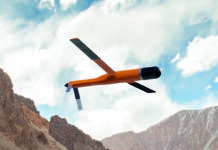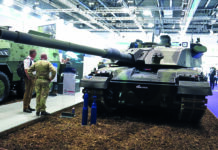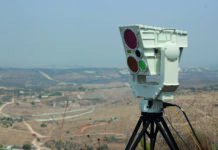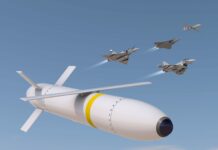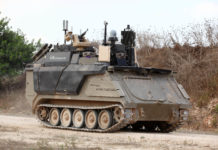When nuclear-armed powers discuss strategic attacks, they often refer to the use of nuclear weapons. However, due to the extremely high costs of total war, such confrontations are luckily often avoided through diplomacy. Nevertheless, large conventional arms have been used in strategic attacks and have remained an important part of warfare since the introduction of nuclear weapons.
Such weapons have been obtained and sometimes used by armies in several conflicts since the 1980s. This article focuses on the offensive and defensive use of those conventional capabilities. Such weapons often take the form of ballistic or cruise missiles with powerful conventional warheads, and/or possessing very high precision guidance. These have the potential to cause massive devastation even without a nuclear warhead. These weapons are capable of crippling vital components of national infrastructure, such as energy, water, and food reserves or communications services. They can bring the economy to a standstill by targeting roadways, railways, and bridges, creating naval blockades, and damaging airport runways. Destroying naval and air defence assets, radars, and command posts is also part of such an offensive, as they protect those infrastructure.
Long-Range Attack
Long-range attacks have always been considered a capability that has the potential to deal a strategic effect on an enemy. Striking deep inside the country’s rear area, an enemy would target critical military and industrial infrastructure. As most such infrastructure is fixed, these targets are often struck by ballistic or cruise missiles, guided to their targets by inertial (INS) and satellite navigation (GNSS). Strategic targets are typically designated such because their destruction would have the potential to have a strategic impact on the war. That is why such targets are typically defended against enemy strikes to the greatest extent possible.
Relocatable targets also considered strategic assets are mobile ballistic or cruise missile launchers, long-range air defence or Anti-Ballistic Missile (ABM) systems, larger classes of ships, submarines, field-deployable command posts. These would typically be classed as ‘short-lived targets’, since location could quickly change from the time a target is detected to the time when an attack is launched. Such strikes rely on short ‘sensor to shooter’ cycles and would require a high level of flexibility in target acquisition and communications, to rapidly launch the appropriate munition at the target, and enabling the operators to upload target updates during the flight.
In the past, deep strikes required an attack force to fly into the enemy’s rear area, risking significant losses to enemy air defence. In the modern age, ballistic and cruise missiles are used for some strategic attacks. The Russian War in Ukraine is demonstrating the use of such capabilities, with Moscow using ballistic and cruise missiles fired from distances of hundreds, or even thousands of kilometres, to hit strategic targets deep inside Ukraine.
Intelligence Prelude
Launched over the horizon, deep strikes require extensive preparations. Determining which targets should be hit, the level of destruction required, and how best to achieve the right effects all require planning. At this preparatory phase, the combined use of different intelligence sources is critical. For static or semi-mobile targets, satellite imagery would be the first choice, but satellites rarely provide intelligence with near-real-time value due to their limited revisit frequency and dependence on weather and cloud coverage. When continuous surveillance of targets is needed, smaller satellites with higher revisit rates can be used. These fly at lower orbits and provide lower resolutions, but utilizing constellations of dozens of satellites, they can keep targets of interest in near-continuous view.
More accurate data is often required for the designation of a target for precision effects. Such information could be obtained by stand-in airborne surveillance, using either optical sensors or Synthetic Aperture Radar (SAR), which would allow real-time assessment of the target surroundings. These can be coupled with Human Intelligence (HUMINT) operatives on-site, or forward observers, thus enabling the shooter to optimise effect and avoid unintended damage and casualties. Battle Damage Assessment (BDA) is also an important capability, as it provides the planners the ability to assess the damage caused by each strike and engage the target again in case of a miss, malfunction, or in pursuit of fleeting targets in its vicinity.
Stealthy aircraft such as the F-35 LIGHTNINGII Joint Strike Fighter (JSF) aircraft are useful assets for targeting long-range strikes, with this capability having been demonstrated in several joint forces exercises, where the JSF provided targeting information for stand-off attacks, in addition to its own inherent capability to carry out strikes.
In our review, we regard long-range strikes as the capability to attack beyond the horizon. But the horizon is a relative term – for an average human at sea level, the distance to the horizon is approximately 4.8 km, but for aerial platforms at high altitudes, the horizon spans can span for hundreds of kilometres. Attacks ‘beyond the horizon’ usually refer to strikes at ranges of 100 km or more, where weapons would require propulsion, communications for mid-course updates or parameter modifications, as well as navigation, and terminal guidance systems.
Deep Strike with Air-Launched Weapons
Deep strikes are often conducted by assets operated in multi-domain operations. Land, sea, or submarine-launched weapons are designed to reach their targets using their own propulsion. These largely fall into the categories of air-breathing engines for cruise missiles or solid propellant for ballistic missiles. Modern missiles are designed to hit their targets from hundreds of kilometres, within a few meters of the targeted point. In the War between Azerbaijan and Armenia ballistic missile attacks were launched over ranges beyond 100 kilometres in conjunction with loitering munitions. The Russian forces that invaded Ukraine in February 2022 used 9M723 ISKANDER-M short-range ballistic missiles, and 9M728 ISKANDER-K cruise missiles, deployed from ground-based launchers. These were supplemented by ship- and submarine- launched KALIBR family cruise missiles. Russia also used hypersonic air-launched missiles (Kh-57M2 KINZHAL) to attack targets as far as Kyiv and Lviv, hundreds of kilometres away. It is assumed that the targeting of such weapons relied primarily on satellite imagery since most of the targets attacked were fixed infrastructure, not mobile or relocatable targets.
When air-launched missiles are used, planners can rely upon the launching aircraft to provide part of the energy for the missile’s flight, providing increased range compared to the same weapon being launched from the ground or sea. This effect can be exploited to develop air-launched standoff weapons which are lighter than their ground- or sea- launched counterparts. Examples include the AGM-158 Joint Air-To Surface Stand-off Missile (JASSM), and the Russian KH-101/102 cruise missiles. This property also allows existing air-launched weapons to be modified for greater range fairly easily.
An example of such modification is the Powered Joint Direct Attack Launched Munition (JDAM) recently introduced by the Boeing company. Boeing suggests adding a small turbojet engine to convert the JDAM into a long-range and versatile payload-carrying platform that will be able to carry weapons or other payloads over a long range. With a range of 1,296 km (700 nautical miles), the Powered JDAM will be able to carry out missions originally designed for JASSM cruise missiles or ADM-160 Miniature Air-Launched Decoy (MALD) at a tenth of the cost of the alternative. Naval cruise missiles also included in this category are the Tomahawk family, and its Russian equivalent, the Kalibr family of missiles.
Other air-launched weapons consist of semi-ballistic missiles such as the RAMPAGE, produced by IAI and Elbit Systems, and Rafael’s ROCKS. Both are used in long-range strikes. The RAMPAGE uses GPS guidance to hit stationary targets at long distances. ROCKS can employ either Rafael’s scene matching or anti-radiation homing guidance. The former uses artificial intelligence and optics to match a target scene to imagery obtained by other means, such as satellite imagery, intelligence sources, and is combined with automatic target recognition. This is the same guidance techniques used by Rafael’s SPICE family guidance kits.
Missile attack is not reserved only for combat aircraft. Using multiple missiles against highly defended targets, will soon be enabled by the US Air Force’s ‘Rapid Dragon’ or ‘arsenal plane’ concept, using pallets carrying either six or nine (depending on aircraft size) cruise missiles, which carried and released from the rear doors of a transport aircraft. This system has so far been tested with AGM-158B JASSM-ER cruise missiles, and when completed will permit launching coordinated multiple cruise missile strikes against targets approximately 1,000 km away. This would enable several transport aircraft to deploy levels of firepower comparable to destroyers and submarines. Multiple pallets of missiles could be deployed from each aircraft, resulting in swarm-like coordinated strikes by low-observable cruise missiles, giving minimal warning to the enemy.
Guided cruise missiles are often used in standoff attacks against air defence and airfields hosting fighter aircraft. As the precision of such weapons improves, the size of their warheads can be reduced while increasing their range and lethality by design optimisation. These effects can be further optimised through warhead selection, and to avoid collateral damage, warhead size and effect should be matched to the target type and guidance accuracy.
Artillery, rockets, and missiles are also becoming effective tools for deep attacks. Current precision rocket artillery can already exceed ranges of 70-90 km, and these weapons would soon deliver ramjet-propelled rounds reaching as far as 150 km. Missiles, such as the Lockheed Martin’s Precision Strike Missile (PRSM) will enable the existing M270 Multiple Launch Rocket System (MLRS) and M142 High Mobility Artillery Rocket System (HIMARS) to hit targets at 499 km with high precision. To attack farther than that, Russian, Chinese, and, most recently also the US, plan to employ hypersonic glide vehicles launched from air, ground, and naval platforms to strike targets at ranges beyond 1,500 km, leveraging the weapons’ high speed to avoid enemy defences. The effective use of such weapons requires real-time targeting information obtained from sensors such as Unmanned Aerial Vehicles (UAV) or satellite imagery. These characteristics enable missile and artillery fire to become an effective player in deep strike multi-domain operations. Artillery duels in East Ukraine have demonstrated the need for such long-range effects with modern artillery fires.
The Offensive Potential of Loitering Munitions
Optimised warheads are also used with loitering munitions to engage ‘short-lived’ targets at long distances. Due to their long-range and endurance characteristics, loitering munitions are used for intelligence gathering, target acquisition, and strikes without relying on external sources. These capabilities are a good enabling factor, because they allow engaging targets with minimal support. Employing passive RF seekers for air defence suppression and optical-based automatic target recognition, loitering munitions such as IAI’s MINI HARPY possess multiple means to detect, identify and track targets. Such loitering weapons can establish effective persistent surveillance deep into enemy territory. Once targets appear, the loitering munitions can quickly detect, locate, and engage such targets of opportunity, with very short sensor-to-shooter cycles.
Deep Strikes Leverage National Defence
Modern technology provides states the power to strike deep into enemy territory and engage strategic targets with a high probability of success, and establish a credible threat over an adversary, maintaining a level of deterrence that could prevent a hostile attack. In the past, maintaining such capabilities required investments in air power and skills beyond the reach of most states. Today, strategic strikes by conventional weapons have become a reality, even for small armies committed to defending the state against external threats.






